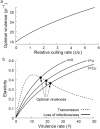Evolutionary repercussions of avian culling on host resistance and influenza virulence
- PMID: 19430529
- PMCID: PMC2675103
- DOI: 10.1371/journal.pone.0005503
Evolutionary repercussions of avian culling on host resistance and influenza virulence
Abstract
Background: Keeping pandemic influenza at bay is a global health priority. Of particular concern is the continued spread of the influenza subtype H5N1 in avian populations and the increasing frequency of transmission to humans. To decrease this threat, mass culling is the principal strategy for eradicating influenza in avian populations. Although culling has a crucial short-term epidemiological benefit, evolutionary repercussions on reservoir hosts and on the viral population have not been considered.
Methods and findings: To explore the epidemiological and evolutionary repercussions of mass avian culling, we combine population genetics and epidemiological influenza dynamics in a mathematical model parameterized by clinical, epidemiological, and poultry data. We model the virulence level of influenza and the selection on a dominant allele that confers resistance against influenza [1, 2] in a poultry population. Our findings indicate that culling impedes the evolution of avian host resistance against influenza. On the pathogen side of the coevolutionary race between pathogen and host, culling selects for heightened virulence and transmissibility of influenza.
Conclusions: Mass culling achieves a short-term benefit at the expense of long-term detriments: a more genetically susceptible host population, ultimately greater mortality, and elevated influenza virulence.
Conflict of interest statement
Figures

 ) and the eventual level of genetic resistance of the population (
) and the eventual level of genetic resistance of the population ( ). Moderate culling (b,c) may shorten the time for the evolution of genetic resistance compared to no culling (a), but fast culling rates (d) will lengthen the evolution time. Very fast culling rates (e) completely suppress an epidemic, but disease can return when culling is discontinued after 2 years. The simultaneous rebound in the susceptible population corresponds to the abrupt decline in overall mortality.
). Moderate culling (b,c) may shorten the time for the evolution of genetic resistance compared to no culling (a), but fast culling rates (d) will lengthen the evolution time. Very fast culling rates (e) completely suppress an epidemic, but disease can return when culling is discontinued after 2 years. The simultaneous rebound in the susceptible population corresponds to the abrupt decline in overall mortality.
 . For culling rates above
. For culling rates above  ,
,  . Note that the resistance threshold is not reached within 10 years for culling rates between
. Note that the resistance threshold is not reached within 10 years for culling rates between  and
and  .
.




 . (b) Optimal virulence coincides with the point where the virulence elasticity of the transmission rate is equal to the virulence elasticity of the rate of infectiousness loss. Increases in the culling rate do not affect the elasticity of transmission but always diminish the elasticity of infectiousness loss, so the optimal virulence increases as the culling rate increases. The virulence elasticity of infectiousness loss is plotted for culling rates
. (b) Optimal virulence coincides with the point where the virulence elasticity of the transmission rate is equal to the virulence elasticity of the rate of infectiousness loss. Increases in the culling rate do not affect the elasticity of transmission but always diminish the elasticity of infectiousness loss, so the optimal virulence increases as the culling rate increases. The virulence elasticity of infectiousness loss is plotted for culling rates  ,
,  , and
, and  .
.References
-
- Ko JH, Takada A, Mitsuhashi T, Agui T, Watanabe T. Native antiviral specificity of chicken Mx protein depends on amino acid variation at position 631. Animal Genetics. 2004;35:119–122. - PubMed
-
- WHO. Cumulative Number of Confirmed Human Cases of Avian Influenza A/(H5N1) Reported to WHO. Geneva: WHO; 2007.
-
- Beigel JH, Farrar J, Han AM, Hayden FG, Hyer R, et al. Avian influenza A (H5N1) infection in humans. New England Journal of Medicine. 2005;353:1374–1385. - PubMed
-
- Bacon PA. The Spectrum of Wegener's Granulomatosis and Disease Relapse. New England Journal of Medicine. 2005;352:330–332. - PubMed
Publication types
MeSH terms
LinkOut - more resources
Full Text Sources
Medical

